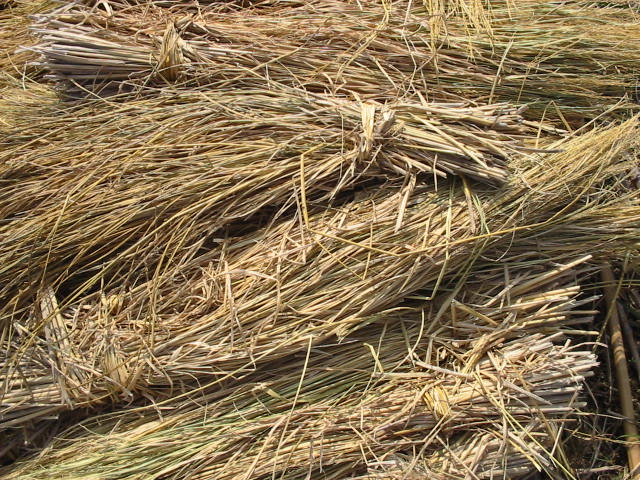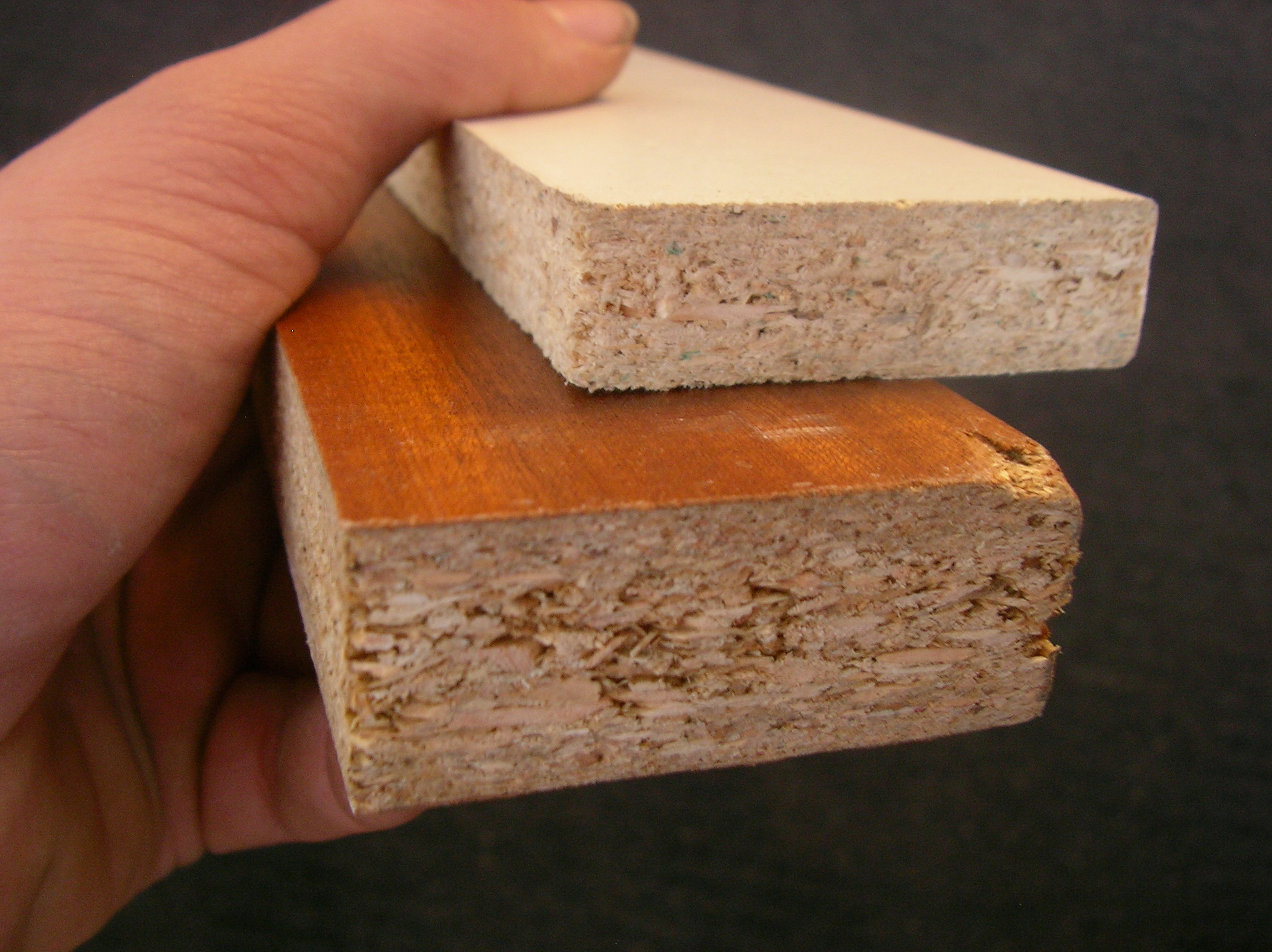|
Strawboard
Oriented structural straw board (OSSB) is an engineered board that is made by splitting straw and formed by adding formaldehyde-free adhesives and then hot compressing layers of straw in specific orientations. Research and development for OSSB panels began in the mid 1980s and was spearheaded by the Alberta Research Council, Canada (today AITF), which identified the straw strand manufacturing technology using formaldehyde-free (p-MDI) adhesives. Uses OSSB can replace wood oriented strand board (OSB) and particle board in structural and non-structural applications, such as interior and exterior walls for house construction, furniture and interior decoration. OSSB panels are formaldehyde-free, they are also used for applications where air quality is a concern, such as kindergartens, hospitals, bedrooms, and hotels. Manufacturing OSSB panel manufacturing starts with careful selection of straw fibres, which are then cut, cleaned, split and dried. Splitting straws allows resin to coa ... [...More Info...] [...Related Items...] OR: [Wikipedia] [Google] [Baidu] |
Straw
Straw is an agricultural byproduct consisting of the dry stalks of cereal plants after the grain and chaff have been removed. It makes up about half of the yield of cereal crops such as barley, oats, rice, rye and wheat. It has a number of different uses, including fuel, livestock bedding and fodder, thatching and basket making. Straw is usually gathered and stored in a straw bale, which is a bale, or bundle, of straw tightly bound with twine, wire, or string. Straw bales may be square, rectangular, or round, and can be very large, depending on the type of baler used. Uses Current and historic uses of straw include: * Animal feed **Straw may be fed as part of the roughage component of the diet to cattle or horses that are on a near maintenance level of energy requirement. It has a low digestible energy and nutrient content (as opposed to hay, which is much more nutritious). The heat generated when microorganisms in a herbivore's gut digest straw can be usefu ... [...More Info...] [...Related Items...] OR: [Wikipedia] [Google] [Baidu] |
Formaldehyde
Formaldehyde ( , ) ( systematic name methanal) is a naturally occurring organic compound with the formula and structure . The pure compound is a pungent, colourless gas that polymerises spontaneously into paraformaldehyde (refer to section Forms below), hence it is stored as an aqueous solution (formalin), which is also used to store animal specimens. It is the simplest of the aldehydes (). The common name of this substance comes from its similarity and relation to formic acid. Formaldehyde is an important precursor to many other materials and chemical compounds. In 1996, the installed capacity for the production of formaldehyde was estimated at 8.7 million tons per year. It is mainly used in the production of industrial resins, e.g., for particle board and coatings. Forms Formaldehyde is more complicated than many simple carbon compounds in that it adopts several diverse forms. These compounds can often be used interchangeably and can be interconverted. *Molecular for ... [...More Info...] [...Related Items...] OR: [Wikipedia] [Google] [Baidu] |
Adhesive
Adhesive, also known as glue, cement, mucilage, or paste, is any non-metallic substance applied to one or both surfaces of two separate items that binds them together and resists their separation. The use of adhesives offers certain advantages over other binding techniques such as sewing, mechanical fastenings, or welding. These include the ability to bind different materials together, the more efficient distribution of stress across a joint, the cost-effectiveness of an easily mechanized process, and greater flexibility in design. Disadvantages of adhesive use include decreased stability at high temperatures, relative weakness in bonding large objects with a small bonding surface area, and greater difficulty in separating objects during testing. Adhesives are typically organized by the method of adhesion followed by ''reactive'' or ''non-reactive'', a term which refers to whether the adhesive chemically reacts in order to harden. Alternatively, they can be organized eit ... [...More Info...] [...Related Items...] OR: [Wikipedia] [Google] [Baidu] |
Alberta Research Council
Alberta Innovates (AI) is an Alberta government provincial corporation whose appointed Board of Directors is accountable to the Minister of Jobs, Economy and Innovation and is responsible for promoting innovation in the province. AI was created from a variety of predecessor research and development organizations including the Alberta Research Council, the Alberta Heritage Foundation for Medical Research and the Alberta Energy Research Institute. History Scientific and Industrial Research Council of Alberta (SIRCA) In the early 1900s, Henry Marshall Tory, the first president of the University of Alberta, lobbied the Alberta government to create an organization to promote research and development (R&D) in the province. In 1921, the government created the Scientific and Industrial Research Council of Alberta (SIRCA). SIRCA was the first provincial R&D organization in Canada. SIRCA's initial mandate was " upportindustries in developing new research, apout Alberta’s geological ... [...More Info...] [...Related Items...] OR: [Wikipedia] [Google] [Baidu] |
Oriented Strand Board
Oriented strand board (OSB) is a type of engineered wood similar to particle board, formed by adding adhesives and then compressing layers of wood Wood is a porous and fibrous structural tissue found in the stems and roots of trees and other woody plants. It is an organic materiala natural composite of cellulose fibers that are strong in tension and embedded in a matrix of ligni ... strands (flakes) in specific orientations. It was invented by Armin Elmendorf in California in 1963. OSB may have a rough and variegation, variegated surface with the individual strips of around , lying unevenly across each other, and is produced in a variety of types and thicknesses. Uses OSB is a material with favorable mechanical properties that make it particularly suitable for load-bearing applications in construction. It is now more popular than plywood, commanding 66% of the North American structural panel market. The most common uses are as Siding (construction), sheathing i ... [...More Info...] [...Related Items...] OR: [Wikipedia] [Google] [Baidu] |
Particle Board
Particle board, also known as chipboard or low-density fiberboard, is an engineered wood product manufactured from wood chips and a synthetic resin or other suitable binder, which is pressed and extruded. Particle board is often confused with oriented strand board (OSB) (also known as flakeboard, or waferboard), a different type of fiberboard that uses machined wood flakes and offers more strength. Characteristics Particle board is cheaper, denser and more uniform than conventional wood and plywood and is substituted for them when cost is more important than strength and appearance. Particleboard can be made more appealing by painting or the use of wood veneers on visible surfaces. Though it is denser than conventional wood, it is the lightest and weakest type of fiberboard, except for insulation board. Medium-density fibreboard and hardboard, also called high-density fiberboard, are stronger and denser than particleboard. Different grades of particleboard have different de ... [...More Info...] [...Related Items...] OR: [Wikipedia] [Google] [Baidu] |
Volatile Organic Compounds
Volatile organic compounds (VOCs) are organic compounds that have a high vapour pressure at room temperature. High vapor pressure correlates with a low boiling point, which relates to the number of the sample's molecules in the surrounding air, a trait known as volatility. VOCs are responsible for the odor of scents and perfumes as well as pollutants. VOCs play an important role in communication between animals and plants, e.g. attractants for pollinators, protection from predation, and even inter-plant interactions. Some VOCs are dangerous to human health or cause harm to the environment. Anthropogenic VOCs are regulated by law, especially indoors, where concentrations are the highest. Most VOCs are not acutely toxic, but may have long-term chronic health effects. Definitions Diverse definitions of the term VOC are in use. Canada Health Canada classifies VOCs as organic compounds that have boiling points roughly in the range of . The emphasis is placed on commonly encount ... [...More Info...] [...Related Items...] OR: [Wikipedia] [Google] [Baidu] |
Borate
A borate is any of several boron oxyanions, negative ions consisting of boron and oxygen, such as orthoborate , metaborate , or tetraborate ; or any salt with such anions, such as sodium metaborate, and disodium tetraborate . The name also refers to certain functional groups in molecules consisting of boron and oxygen, and esters with such groups, such as triethyl orthoborate . Natural occurrence Borate ions occur, alone or with other anions, in many borate and borosilicate minerals such as borax, boracite, ulexite (boronatrocalcite) and colemanite. Borates also occur in seawater, where they make an important contribution to the absorption of low frequency sound in seawater. Borates also occur in plants, including almost all fruits. Anions The main borate anions are: * tetrahydroxyborate , found in sodium tetrahydroxyborate . * orthoborate , found in trisodium orthoborate * perborate , as in sodium perborate * metaborate or , found in sodium met ... [...More Info...] [...Related Items...] OR: [Wikipedia] [Google] [Baidu] |
Oriented Strand Board
Oriented strand board (OSB) is a type of engineered wood similar to particle board, formed by adding adhesives and then compressing layers of wood Wood is a porous and fibrous structural tissue found in the stems and roots of trees and other woody plants. It is an organic materiala natural composite of cellulose fibers that are strong in tension and embedded in a matrix of ligni ... strands (flakes) in specific orientations. It was invented by Armin Elmendorf in California in 1963. OSB may have a rough and variegation, variegated surface with the individual strips of around , lying unevenly across each other, and is produced in a variety of types and thicknesses. Uses OSB is a material with favorable mechanical properties that make it particularly suitable for load-bearing applications in construction. It is now more popular than plywood, commanding 66% of the North American structural panel market. The most common uses are as Siding (construction), sheathing i ... [...More Info...] [...Related Items...] OR: [Wikipedia] [Google] [Baidu] |




